The history of New Orleans music is overflowing with venues where the musicians of the city have plied their trade and developed the myriad styles the city has been known for since its earliest days. From the Funky Butt and the Iroquois Theater on North Rampart Street where Buddy Bolden and a young Louis Armstrong wowed early 20th century crowds, to the famed Dew Drop Inn on Lasalle Street in Central City, which was an epicenter on both the national “chitlin’ circuit” and home to local R&B legends like Earl King and Guitar Slim.
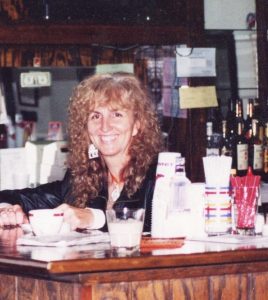
Donna Poniatowski Sims tending the bar in the first year of operation. Photo courtesy of Donna Poniatowski
The Nitecap on Louisiana Avenue was an early proving ground for the Meters in the late 1960s, the Caldonia in the Tremé neighborhood was a hotbed of talent before the development of Armstrong Park. The Glass House on South Saratoga Street, blocks from the Dew Drop, hosted the Dirty Dozen Brass Band and the Rebirth Brass Band in their early years, solidifying the resurgence of brass band music after a moribund period in the ’60s.
There are just a handful of many other venues, like Kemp’s and the Rose Tattoo, that have been kept alive in memory and the history books. Undoubtedly there is also an untold number of other clubs that have disappeared from the collective consciousness amid the passages of time.
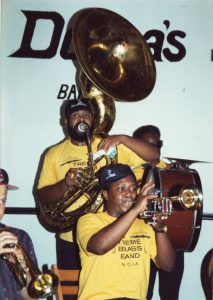
Kirk Joseph and Kermit Ruffins at Donna’s. Photo courtesy of Donna Poniatowski
But the story of most of these establishments has never been fully told. Even in our era, there is no book about Tipitina’s or the Maple Leaf Bar, two venues that have been around since the 1970s and continue to play a role in the development of the music scene. Some of the principals of these places are still alive, but time waits for no one, and it is running out like it ran out on so many places from so many other eras.
So, it’s refreshing to report that a book about another iconic club has been written. It’s a first-person account written by the namesake of Donna’s Bar and Grill.
You will have to wait to read the book, which is due in the coming months, for the full story but briefly, Donna’s was known as the “Brass Band Headquarters” during its lifetime on North Rampart Street across from the archway entrance to Armstrong Park. While the building still stands, only the memories remain.
From 1993 until the business closed in 2010, Donna’s was an incubator for local talent in a variety of genres and a throwback to another era when people of all ages and races mingled, shook their butts and partied to the soundtrack of New Orleans. Gorgeous photographs in the elegant tome, shot by the author Donna Poniatowski Sims, depict a pre-teen Troy “Trombone Shorty” Andrews, Kermit Ruffins in his youth and hundreds of other musicians.
I spoke with Donna ahead of publication to whet future readers’ appetite for this scintillating tale that is replete with deep history and personal experiences. Full disclosure, I spent hundreds of nights at Donna’s and the club is featured in my book, Up Front and Center: New Orleans Music at the End of the 20th Century.
“I actually first thought about the book around 2018, after Charlie (her husband and the chef at Donna’s) passed, crossed over, because I was going to help him write a cookbook at first.” Donna said. “That was kind of the seed for it, but I couldn’t do it at that time because I was too close to it.”
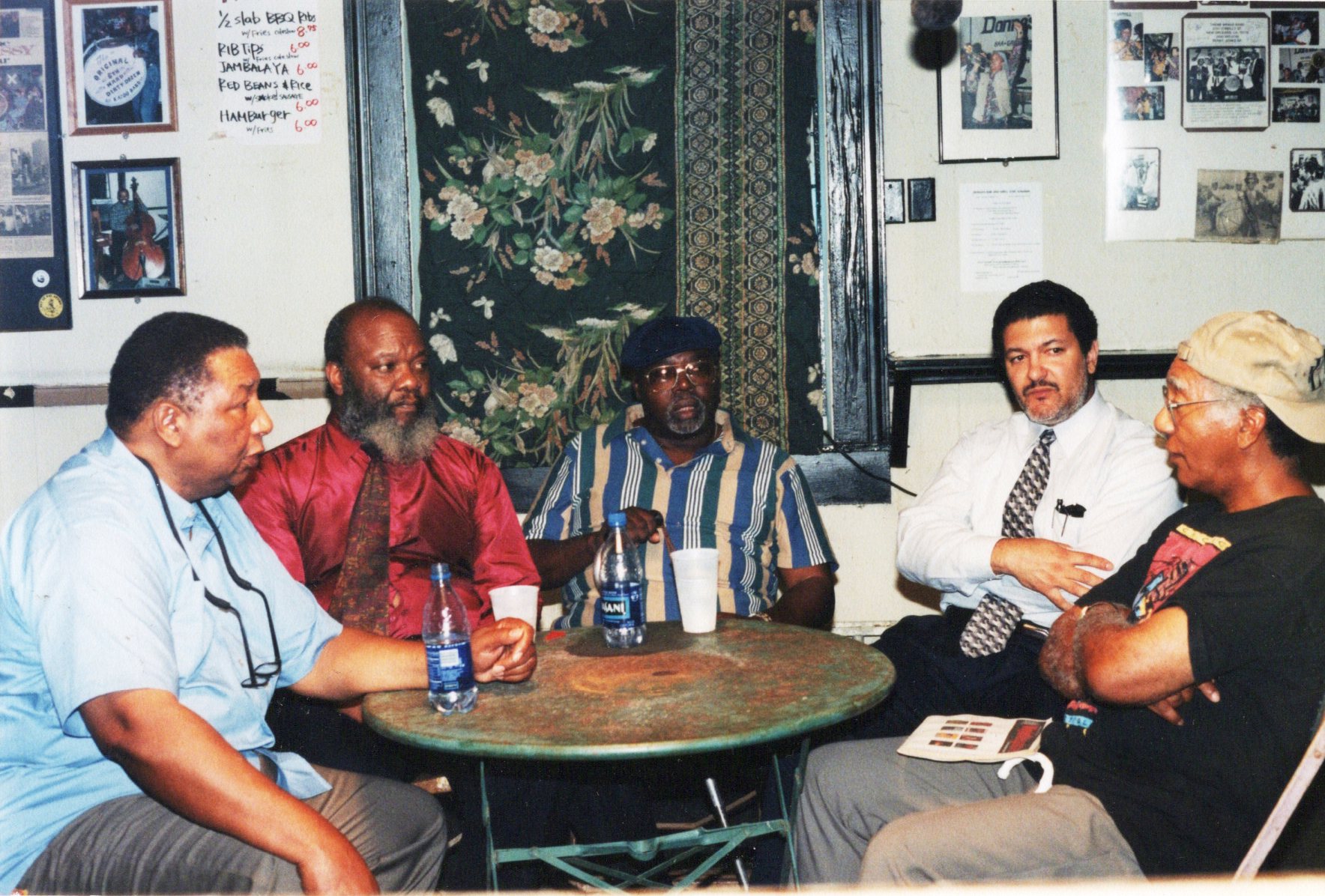
Bob French, Walter Payton, Smoky Johnson, Don Vappie and Edward “Kidd” Jordan. Photo courtesy of Donna Poniatowski
Charlie Sims was also the head chef on the Amtrak “City of New Orleans” train, which runs between Chicago and New Orleans. An encounter he had with the members of the Tremé Brass Band was a catalyst for the club to begin presenting brass band music. But before that happened, Donna began booking blues musicians that were busking in the French Quarter.
“In the first few months, I had people from the square [Jackson Square], it was a good time, but they couldn’t make any money in my place… meanwhile I had been talking to Charlie about the brass bands. I said, ‘Look, we have a brass band culture here that is awesome, and I want them in the place,’ but nobody was really playing inside. I knew there was a reason for that. It was kind of like they were looked on as street bands… so I said, ‘I think we need to go into Tremé and get a brass band.’”
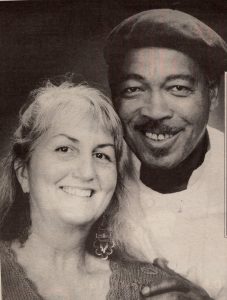
Donna and Charlie Sims. Photo by David Richmond, courtesy of Donna Poniatowski
Charlie Sims was from Chicago, so he was not as familiar with the brass band culture of New Orleans as Donna. But as luck would have it, she said, “He came back home and he busted through the door and says, ‘Oh my gosh, I know what you mean about a New Orleans brass band. I heard Tremé Brass Band on the train.’ I said, ‘You did? Did you ask them about a gig?’ and that’s how it all got started.”
Donna’s Bar and Grill also featured traditional jazz throughout its history. The book details how the author’s early involvement with presenting live music at her first club on Bourbon Street in the late 1970s, which she owned with her first husband for around three years, influenced the bookings at Donna’s. She said, “Some of the musicians that I’d known since my first place, they were the traditional jazz musicians.”
Since photography was, and still is, an important part of Donna’s life and work, she discusses in the book the role the world-famous photographer Herman Leonard played in helping and encouraging her to take photos. She said, “He motivated me to keep taking photos. I documented what was going on in Donna’s, not because I had the idea that I was going to do a book but just because it was a fun thing to do.” She continued, “I mean when Wynton Marsalis came into my place, don’t you think I needed a photograph of him?”
In essence there are two books in Donna’s Bar and Grill—New Orleans. She explained, “I kind of wrote the narrative first. Then I went back to adjust it and that’s when I started really looking at photos. The photos had to be of that time to fit the narrative and they’re all on film. Every time I would write something and look for a photo, I had to digitize it.”
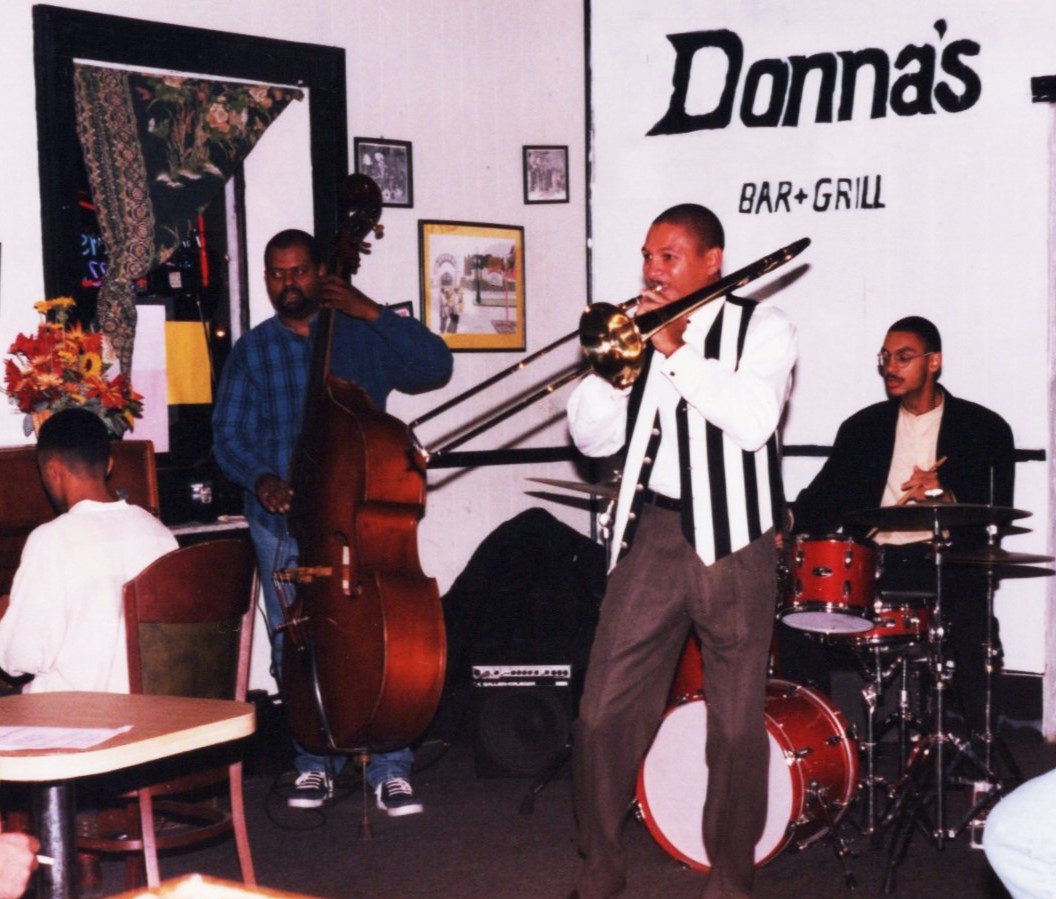
Dwight Fitch, Kevin Morris, Delfeayo Marsalis and Jason Marsalis. Photo courtesy of Donna Poniatowski
Readers will be amazed at everything Donna has included in this labor of love and impressive historical document. Most of the musicians and bands that played at the club are profiled. The accompanying photographs will astound and astonish music lovers who weren’t there at the time and cause flashbacks in the brain of those who were.
“This story is quite unique, I didn’t realize at the time,” Donna said with a chuckle. That’s an understatement. This book is a testament to a time and a place that remains potent in memory and important in history.
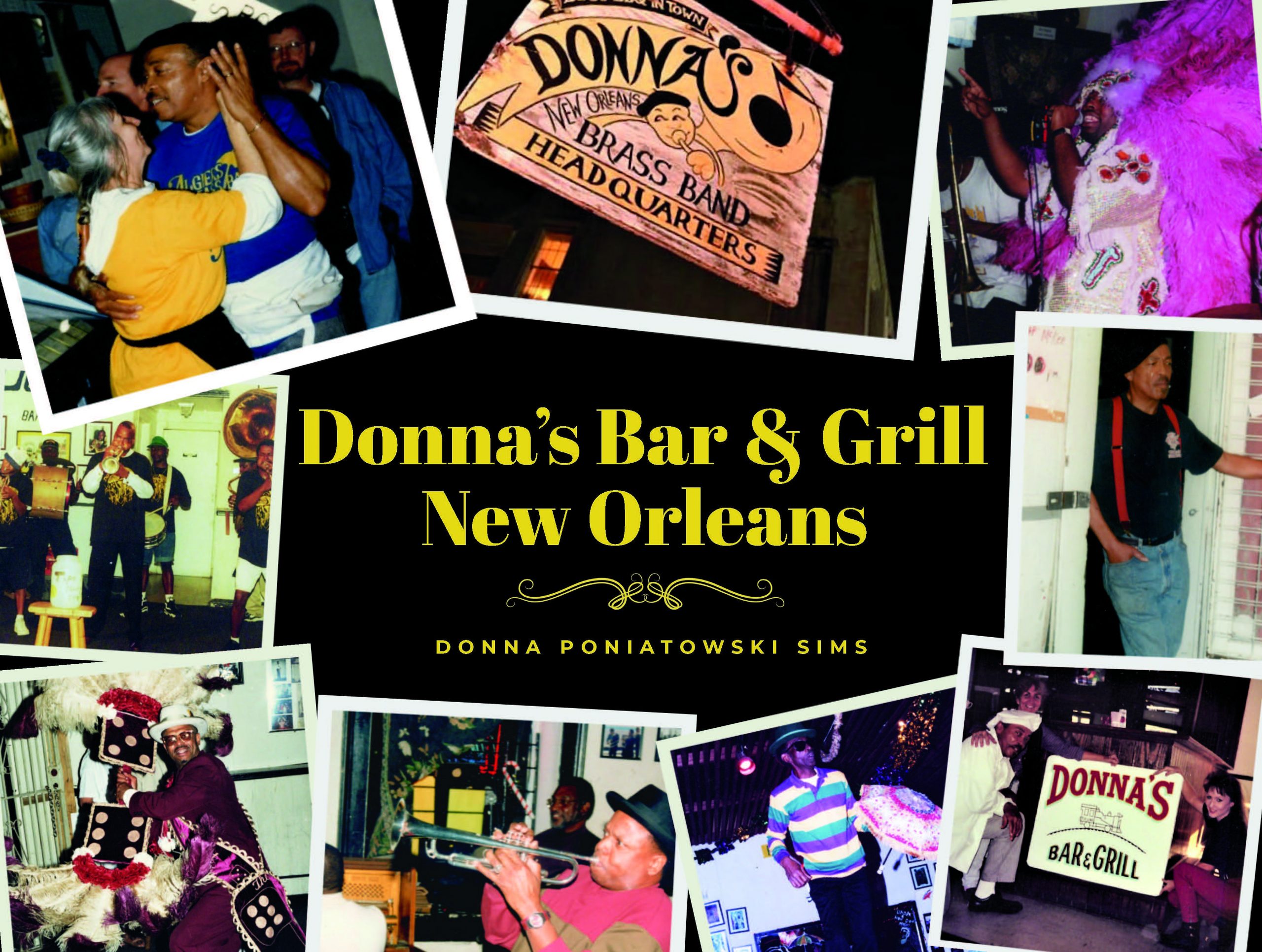
Donna’s Bar and Grill




